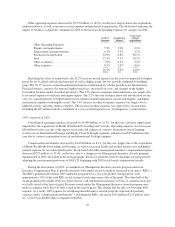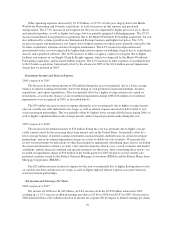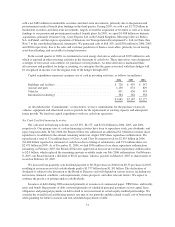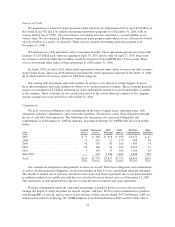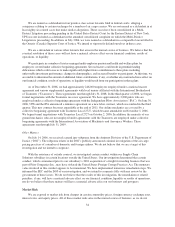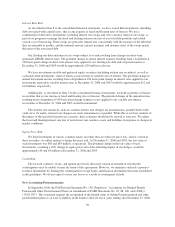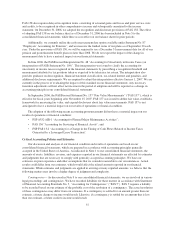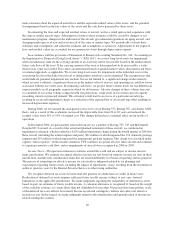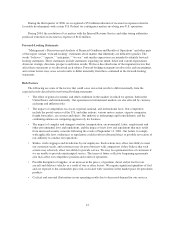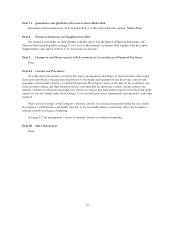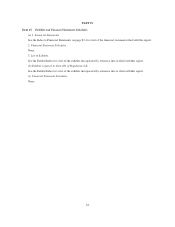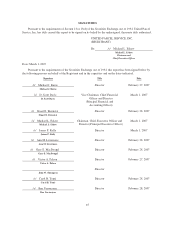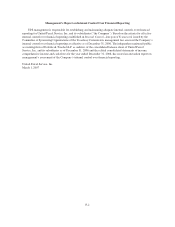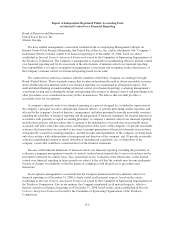UPS 2006 Annual Report Download - page 53
Download and view the complete annual report
Please find page 53 of the 2006 UPS annual report below. You can navigate through the pages in the report by either clicking on the pages listed below, or by using the keyword search tool below to find specific information within the annual report.The events that may impact our contingent liabilities are often unique and generally are not predictable. At
the time a contingency is identified, we consider all relevant facts as part of our FAS 5 evaluation. We record a
liability for a loss that meets the recognition criteria of FAS 5. These criteria require recognition of a liability
when the loss is probable of occurring and reasonably estimable. Events may arise that were not anticipated and
the outcome of a contingency may result in a loss to us that differs from our previously estimated liability. These
factors could result in a material difference between estimated and actual operating results. Contingent losses that
meet the recognition criteria under FAS 5, excluding those related to income taxes and self insurance which are
discussed further below, were not material to the Company’s financial position as of December 31, 2006. In
addition, we have certain contingent liabilities that have not been recognized as of December 31, 2006, because a
loss is not reasonably estimable.
Goodwill Impairment— We account for goodwill in accordance with Statement of Financial Accounting
Standards No. 142, “Goodwill and Other Intangible Assets” (“FAS 142”), which requires annual impairment
testing of goodwill for each of our reporting units. Goodwill impairment testing requires that we estimate the fair
value of our goodwill and compare that estimate to the amount of goodwill recorded on our balance sheet.
We use a discounted cash flow model (DCF model) to estimate the fair value of our goodwill. The
completion of the DCF model requires that we make a number of significant assumptions to produce an estimate
of future cash flows. These assumptions include projections of future revenue, costs and working capital changes.
In addition, we make assumptions about the estimated cost of capital and other relevant variables, as required, in
estimating the fair value of our reporting units. The projections that we use in our DCF model are updated
annually and will change over time based on the historical performance and changing business conditions for
each of our reporting units.
As of December 31, 2006, our recorded goodwill was $2.533 billion, of which $2.243 billion relates to our
Supply Chain and Freight segment. This segment of our business has experienced rapid growth over the last
several years, largely due to a number of acquisitions that we have made. Because of its growth, this segment
continues to experience significant change as we integrate the acquired companies, resulting in higher volatility
in our DCF model projections than for our other segments. Our annual impairment tests performed in 2006, 2005
and 2004 resulted in no goodwill impairment.
Self-Insurance Accruals—We self-insure costs associated with workers’ compensation claims, automotive
liability, health and welfare, and general business liabilities, up to certain limits. Insurance reserves are
established for estimates of the loss that we will ultimately incur on reported claims, as well as estimates of
claims that have been incurred but not yet reported. Recorded balances are based on reserve levels determined by
outside actuaries, who incorporate historical loss experience and judgments about the present and expected levels
of cost per claim. Trends in actual experience are a significant factor in the determination of such reserves. We
believe our estimated reserves for such claims are adequate, but actual experience in claim frequency and/or
severity could materially differ from our estimates and affect our results of operations.
Workers’ compensation, automobile liability and general liability insurance claims may take several years to
completely settle. Consequently, actuarial estimates are required to project the ultimate cost that will be incurred
to fully resolve the claims. A number of factors can affect the actual cost of a claim, including the length of time
the claim remains open, trends in health care costs and the results of related litigation. Furthermore, claims may
emerge in future years for events that occurred in a prior year at a rate that differs from previous actuarial
projections. Changes in state legislation with respect to workers compensation can affect the adequacy of our
self-insurance accruals. All of these factors can result in revisions to prior actuarial projections and produce a
material difference between estimated and actual operating results.
We sponsor a number of health and welfare insurance plans for our employees. We use estimates from third
party actuaries to establish the liabilities for these plans. These liabilities and related expenses are based on
38


